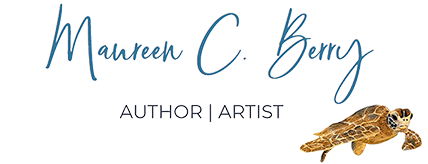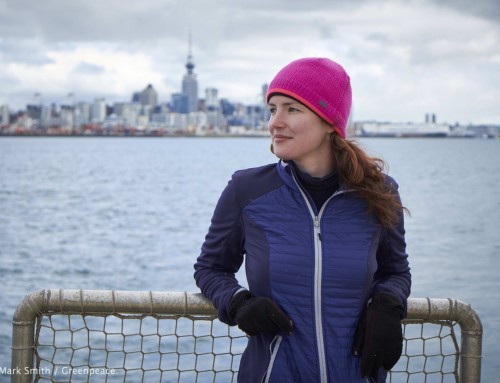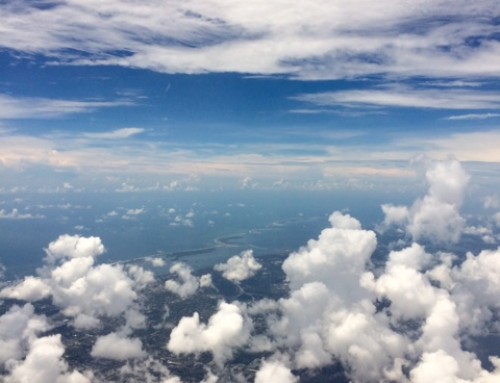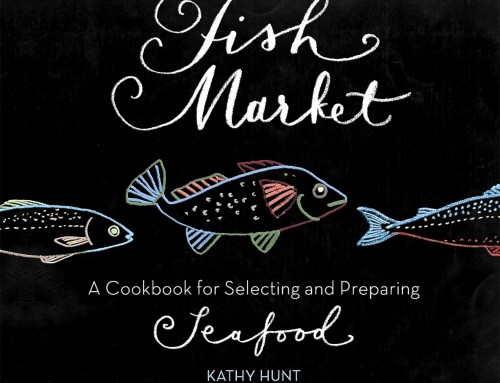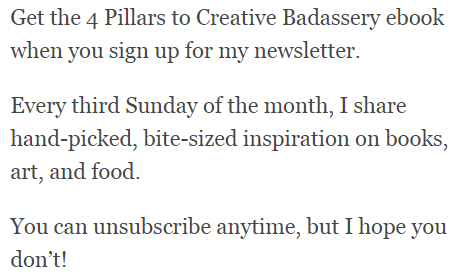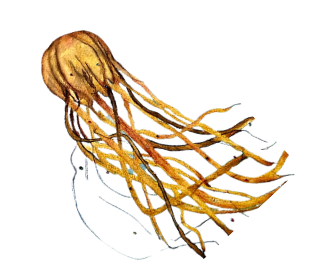Ever wonder what life is like as an Alaska salmon fisherman?
Meet Mary Smith, @MaryInSitka, Alaska salmon troller. In my #KnowYourFisherman series, where I highlight a fisherman, organization or company working to support sustainable seafood or a sustainable food system, I interviewed Mary via email and Twitter to find out exactly what life is like aboard a salmon fishing vessel in Alaska.
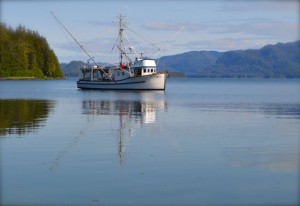
Maureen C. Berry: What’s the name of your boat(s)/fleet?
Mary Smith: The F/V Virga.
MCB: Who else is on the boat with you?
MS: David Whitmire, my husband.
MCB: How long have you been salmon fishing?
MS: Last season was my 4th year trolling for salmon. I also long-lined for halibut during the summer of 2010.
MCB: What species of salmon do you fish?
MS: We fish for King Salmon and Coho salmon, and every once in a while for chum.
MCB: Why do you fish for king and coho? Can you be specific?
MS: We fish for king and coho salmon because that’s what allocated to us by the State of Alaska. We own a power troll permit and although we can keep and catch other salmon, like chum or sockeye, the state opens different areas at different times for different species. For us, king and coho make the most sense.
MCB: How long is the salmon season?
MS: Trollers have the opportunity to fish almost year round. We concentrate on some spring fishing in May and June, and then our main summer king opener starts on July 1. The length of that opener depends on the amount of fish we are allocated and how fast they are harvested (which in turn is dependent on weather, the fish, the effort and various other factors). Once we catch our allocation we switch over to targeting coho, fishing until mid to late September.
MCB: Since you are fishing with your husband, it must be easier to stay out, or no? 🙂
MS: We are an amazing team, and we have a lot of fun together. Sure, we have our challenges but we’ve gotten really good at working them out. We have to—there’s no where to run away to! We actually have a lot of fun, we joke and talk and dream out loud. We always take some time (well, almost always) to try and sit down and have at lease one civilized meal during the day. But I’ll be honest that once we hit the bunk its immediate zzzzz’s for both of us!
MCB: How challenging is the work physically on a scale of one to ten? One being easy.
MS: It ranges—there are definitely days when you are really in the fish and it’s four in the afternoon and it’s kind of rocking and rolling out on the sea and you can tell you’ve still got another six, seven hours of constant labor in front of you that you have no idea how you are going to make it. Definitely days like that are a ten. By August we both have carpel tunnel syndrome pretty bad and you have to battle a lot of constant pain issues. The quality of the fish depends on you not faltering; nothing can wait until later. There is no “later” so the work has got to get done, no matter how tired or sore you are. We listen to a lot of music and there are times when we just have to put on some disco or something crazy and crank it up really loud and just work!
MCB: What about emotional challenges?
MS: I love being out on the sea, and my husband is so experienced and competent that with him at the helm I am never scared, even in rough weather.
MCB: Political challenges?
MS: I have my moments at times. I have a lot of land-locked experience dealing with seafood and I am one of the few fishermen that will defend fish farming so I can find myself challenged on that front. Like any industry we have a wide range of political and social views so sure there are moments when we find ourselves at odds with one another. One thing we ALL agree on is long term sustainability of our industry. We’re all conservationists who want the best for the ocean.
MCB: What are your biggest overall challenges?
MS: Working as a direct marketer of our own fish is tough—a lot of fishermen in our fleet deliver to local processors which allows them to turn around trips quickly and efficiently. The processors buy the fish and then handle everything beyond that—processing, freezing, packaging, sales, marketing, PR, accounts receivable, etc. We are more of a one-stop-shop. We offload our own fish, make sure it’s held and transported properly, find a cold storage facility to keep it in, sell it, promote it , collect on the sales, etc. on top of doing all the fishing and processing on board. It’s a lot of work. But it’s worth it.
MCB: What is one or two things you wish you had on the boat that you don’t?
MS: A hot tub! Seriously, maybe a little more comfortable bunk—but then that would making getting up before dawn even harder! We keep things pretty stocked, always good food of all kinds available so you’re never really craving anything. Some to clean up after us would be nice—or a dishwasher! Sometimes at the end of the day it’s all you can do to wash your dinner dishes.
MCB: Do you do day-trips or stay on the boat?
MS: Because we freeze on board our boat we can stay out for longer trips. We’ve done five days trips, up to our longest trip which was 28 days. Two to three weeks is about average.
MCB: What body of water do you fish?
MS: We fish the Pacific Ocean. More specifically the Gulf of Alaska from the Canada/Alaska border up to just north of Yakutat. We fish near shore, in the inside passage, and as far offshore as the Fairweather Grounds which are approximately 40 miles offshore.
MCB: What gear do you use?
MS: We are trollers, our fish are harvested by hook and line.
MCB: How do you harvest the fish? MCB: How much bycatch do you hook and what do you do with the bycatch fish? MCB: Do you see signs that the Alaska salmon industry is threatened by competition, climate, politics, etc? Climate change is and will continue to impact our fishery. Although it’s hard to pinpoint exactly how and when. Drought in California and the Pacific Northwest is causing problems for salmon as they struggle to spawn in dried-out rivers and streams. Changing ocean temps mean that we see different fish in non-traditional areas. Mining and logging operations in the US and Canada also continue to have a negative impact on salmon. MCB: Regarding changing ocean temperatures and seeing other species, can you be more specific? For instance, what species have you seen and how often? MCB: Are there opportunities in Alaska for women as start-up fishers? MCB: The commercial fishing industry has been considered a man’s world for a long time. What challenges do you see for women, if any? MCB: Are you involved with a Community Supported Fishery (CSF)? Or if not, why? MCB: Where can the Alaska salmon-lover buy your salmon? Thanks Mary! Keep up the terrific work! Want to find out more about Mary and her Alaska salmon? Check out Springline Seafood. Got a question or comment for Mary? Reply in the comments!
MS: Hand pick,
MS: We have very little bycatch—a few halibut, ling cod, rockfish, sharks, all of which we carefully release live.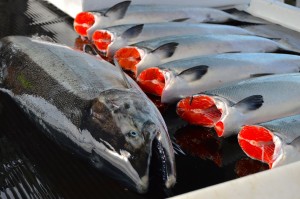
MS: We deal with our fair share of political wrangling. Since our salmon cross a variety of boundaries there is always a question of “ownership”. We have to collaborate with a variety of users—Oregon, Washington, Canada, Alaska. Different governments, Tribal governments, state, federal, local. Also, different fisheries target salmon—trollers, seiners, gill netters, set netters along with recreational and subsistence fishermen of all types. It’s a big party that’s not always fun.
MS: Some fishermen caught a fair amount of tuna in SE AK this summer—I think that’s a relatively new phenomenon. We had sightings of mola mola (I know of two in Prince William Sound) which is also very rare.
MS: Yes, Alaska is a great place for women to work—as deckhands and as captains, on fishing vessels, tenders or in processing plants as well as in boat building, repair, refrigeration or in conservation, enforcement, research—lots of jobs that appeal to differently personalities and interests! We have many female friends that excel in every single profession—from long-time boat owners and captains to first-season deckhands.
MS: The same challenges women face on a daily basis—being judged unfairly because of their sex; that they won’t be able to handle the labor, that they’ll disrupt a boat’s dynamics. There are (and have been) women in the fleet forever—sometimes its just a matter of “seeing” them. The at-home role that any fisherman’s family plays is integral to his or her success, so just because we don’t see a woman hauling gear or at the wheel doesn’t mean there isn’t one at home handling endless paperwork or tax issues, or making sure everyone’s nets are mended or that they have the proper gear, etc.
MS: We sell mostly to wholesalers but do a bit of direct sales when we travel or out of our home. It’s a lot of work to sell fish a pound at a time, so we’re partial to 1000 lb. plus purchases!
MS: We sell to multiple retailers (Alfalfa’s in the Denver area, Lunds and Byerely’s in Minnesota) along with a select group of high-end restaurants around the country. It’s difficult for us to sell direct although we do some limited direct marketing. Check out our website to join our mailing list—you never know when we might pop up in your neighborhood!
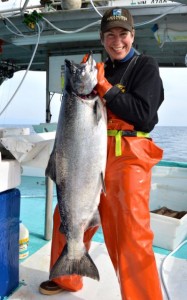 Mary Smith @MaryInSitka is a commercial salmon troller currently working out of Sitka, Alaska. Along with her husband, David Whitmire, Smith direct markets her frozen-at-sea king and coho salmon under the Springline Seafood label. Smith is a graduate of the Culinary Institute of American and spent 15 years in the seafood industry, mostly in sales and marketing. (photos courtesy Mary Smith)
Mary Smith @MaryInSitka is a commercial salmon troller currently working out of Sitka, Alaska. Along with her husband, David Whitmire, Smith direct markets her frozen-at-sea king and coho salmon under the Springline Seafood label. Smith is a graduate of the Culinary Institute of American and spent 15 years in the seafood industry, mostly in sales and marketing. (photos courtesy Mary Smith)
